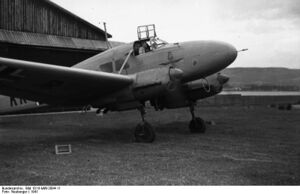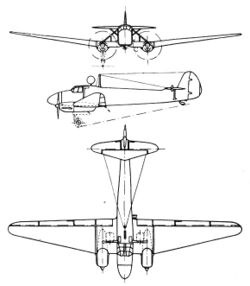Engineering:Focke-Wulf Fw 58 Weihe
| Fw 58 Weihe | |
|---|---|

| |
| Role | Trainer, Transport, Air Ambulance |
| Manufacturer | Focke-Wulf |
| First flight | 1935 |
| Introduction | 1937 |
| Retired | 1940s |
| Primary user | Luftwaffe |
| Number built | 1,350 |
The Focke-Wulf Fw 58 Weihe (Harrier) was a German aircraft, built to fill a request by the Luftwaffe for a multi-role aircraft, to be used as an advanced trainer for pilots, gunners and radio operators.
Design and development
The Fw 58 was a low-wing monoplane with two piston engines mounted in nacelles on the wing leading edges. The crew sat under an enclosed canopy. Aft of the flight deck, the fuselage was open to form a moveable machine gun station. The tailwheel undercarriage was retractable.
Operational history
The Fw 58 was widely used for training Luftwaffe personnel. It was also used as a VIP transport, ambulance, feeder airliner, photo reconnaissance and weather research aircraft.[1] It was built under license in Bulgaria, Hungary and Brazil . It was also operated by several countries such as the Netherlands, Romania, Croatia and Turkey.
Variants
- Fw 58 V1
- First prototype, first flown in 1934[2]
- Fw 58 V2
- Second prototype.
- Fw 58 V3
- Third prototype.
- Fw 58 V4
- Fourth prototype.
- Fw 58 V14
- Fw 58 V14, D- OPDR, was fitted with Fowler flaps and boundary-layer suction for high-lift experiments at AVA, Göttingen. The suction system was powered by a Hirth aircraft engine in the fuselage and the air exited through two circumferential, parallel rows of slots in the rear fuselage section.[3]
- Fw 58B
- Fw 58B-1
- Fw 58B-2
- This version had a glazed nose and was armed with a 7.92 mm (0.312 in) MG 15 machine gun.
- Fw 58C
- Fw 58W
- Twin-floatplane version.
Operators
 Austria
Austria
 Argentina
Argentina
- Argentine Air Force - 3 imported, (1938–1952)[4]
 Brazil
Brazil
- Brazilian Navy - license-built from 1938[5]
- Brazilian Air Force
- Syndicato Condor
- Varig
 Bulgaria
Bulgaria
- Bulgarian Air Force - 8 imported in 1937-1939[6]
 Czechoslovakia
Czechoslovakia
 Finland
Finland
 Nazi Germany
Nazi Germany
- Luftwaffe
 Hungary
Hungary
- Hungarian Air Force - license production
 Netherlands
Netherlands
 Norway
Norway
- Royal Norwegian Air Force (Postwar)
 Poland
Poland
 Romania
Romania
- Royal Romanian Air Force
- Romanian Air Force (Postwar)
- Transnistrian air section
 Slovakia
Slovakia
 Spain
Spain
 Turkey
Turkey
- Turkish Air Force - at least 6, received 1937[7]
 Soviet Union
Soviet Union
Surviving aircraft
The only Fw 58 on display is at Museu Aeroespacial in Rio de Janeiro, Brazil. Brazil used this airplane mainly for maritime patrols and the example on display was one of the 25 Fw 58B-2 units license-built in Brazil by Fábrica de Galeão, circa 1941.
An Fw 58 C-2 is stored in the Norwegian Aviation Museum in Bodø.[8]
An Fw 58 C crashed on 30 March 1943 in the Lac du Bourget, France, after a low-flying training pass over the lake went wrong. Two of the four airmen on board were rescued by local fishermen. The wreckage lies at a depth of over 112 meters. Due to the dark and cold water, it is still fairly well preserved, though the canvas over the tube frame light structure is gradually deteriorating. A proposal has been made to raise the wreckage, but local divers are strongly opposed because of its status as a war grave, and the risks of damaging it.[citation needed]
Specifications (Fw 58B)
Data from Die Deutsche Luftrüstung 1933–1945 Vol.2 – Flugzeugtypen Erla-Heinkel[2]
General characteristics
- Crew: 4
- Length: 14.1 m (46 ft 3 in)
- Wingspan: 21 m (68 ft 11 in)
- Height: 4.2 m (13 ft 9 in)
- Wing area: 47 m2 (510 sq ft)
- Airfoil: NACA 2212[9]
- Empty weight: 2,000 kg (4,409 lb)
- Gross weight: 2,930 kg (6,460 lb)
- Fuel capacity: 340 L (90 US gal; 75 imp gal) in two centre-section tanks, with a 34 L (9.0 US gal; 7.5 imp gal) oil tank
- Powerplant: 2 × Argus As 10C V-8 inverted air-cooled piston engines 240 PS (240 hp; 180 kW)
- Propellers: 2-bladed variable-pitch propeller, 2.5 m (8 ft 2 in) diameter
Performance
- Maximum speed: 254 km/h (158 mph, 137 kn) at sea level
- Cruise speed: 238 km/h (148 mph, 129 kn) * Landing speed: 76 km/h (47 mph; 41 kn)
- Range: 690 km (430 mi, 370 nmi)
- Service ceiling: 5,400 m (17,700 ft)
- Rate of climb: 4.67 m/s (919 ft/min)
- Time to altitude: 1,000 m (3,300 ft) in 3 minutes 48 seconds
- Wing loading: 59.8 kg/m2 (12.2 lb/sq ft)
Armament
- Guns: * 2 × 7.92 mm (.312 in) MG 15 machine guns
See also
Related lists
- List of aircraft of World War II
- List of World War II military aircraft of Germany
- List of military aircraft of Germany
References
- ↑ Wilson, James (2007). Propaganda Postcards of the Luftwaffe. England: Pen and Sword. p. 60. ISBN 978-1844154913.
- ↑ Jump up to: 2.0 2.1 Nowarra, Heinz J. (1993) (in de). Die Deutsche Luftrüstung 1933–1945 Vol.2 – Flugzeugtypen Erla-Heinkel. Koblenz: Bernard & Graefe Verlag. pp. 60–63, 264–265. ISBN 3-7637-5464-4.
- ↑ Luftfahrt international 18 (1976), pp. 2829ff
- ↑ FR010 Fw 58B South America
- ↑ "THE FOCKE WULF Fw 58 IN BRAZIL". http://www.rudnei.cunha.nom.br/FAB/en/fw-58.
- ↑ Focke-Wulf Fw 58 Gulub
- ↑ Oryx. "Bye Bye Berlin: Türkiye’s He 111 Bombers". https://www.oryxspioenkop.com/2023/01/bye-bye-berlin-turkiyes-he-111-bombers.html.
- ↑ Norsk Luftfartsmuseum
- ↑ Lednicer, David. "The Incomplete Guide to Airfoil Usage". https://m-selig.ae.illinois.edu/ads/aircraft.html.
Bibliography
- Kulikov, Victor (March 2000). "Des occasions en or pour Staline, ou les avions allemands en URSS" (in fr). Avions: Toute l'Aéronautique et son histoire (84): 16–23. ISSN 1243-8650.
- Kulikov, Victor (April 2000). "Des occasions en or pour Staline, ou les avions allemands en URSS" (in fr). Avions: Toute l'Aéronautique et son histoire (85): 44–49. ISSN 1243-8650.
External links
 |


